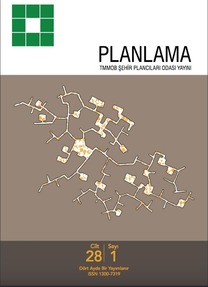Expression of Arts-Driven Social Co-presences in the Beyoğlu’s Spatial Culture
Sanat Aracılığı ile Bir Arada Olma Durumları ve Beyoğlu’nun Mekânsal Kültüründeki Yansımaları
___
American Planning Association, 2007. Planning and Urban Design Standards. New Jersey: Wiley and Sons.Arslanli, K. Y. Dokmeci V. and Kolcu H., 2017. The effect of Pedestrianization of Istiklal Caddesi on land values and transformation of urban landuse. ITU A/Z, 14(2): 31-41.
Dokmeci, V., Altunbas, U. and Yazgi, B., 2007. Revitalization of the main Street of a distinguished old neighborhood in Istanbul, European Planning Studies 15(1), 153-166.
Działek, J. and Murzyn-Kupisz, M., 2014. Young artists and the development of artistic quarters in Polish cities. Belgeo,3, pp:1-30.
Enlil M. Z, Evren Y., Dincer, I., 2011. Cultural triangle and beyond: a spatial analysis of cultural industries in Istanbul. Planning, Practice and Research, 2011 (26): 167-183.
Gordon, I.R. and McCann, P., 2000. Industrial clusters: complexes, agglomeration and/or social networks?, Urban Studies, 37, pp. 513-532.
Gornostaeva, G. and Campbell, N., 2012. The creative underclass in the production of place: example of Camden Town in London. Journal of Urban Affairs, 34:(2), pp. 169-188.
Green, N., 1999. Artists in the East End 1968-1980, Rising East, 3 (2), pp. 20-37.
Heebels, B. and van Aalst I., (2010). Creative clusters in Berlin: Enterprenships and the quality of place in Prenlauer Berg and Kreuzberg, Human Geography, 92 (4), pp: 347-363.`
Hillier, B. and Hanson, J., 1989. The social logic of space. Cambridge University Press.
Hillier, B., Penn, A., Hanson, J. and Grajewski, J., 1993. Natural movement: or, configuration and attraction in urban pedestrian movement. Environment & Planning B: Planning & Design, 20, pp: 29-66.
Hillier, B. et al., 1993. Natural movement: or, configuration and attraction in urban pedestrian movement. Environment & Planning B: Planning & Design (20): 29-66.
Hillier, B., 1996. Cities as movement economies. Urban Design International, 1, pp: 49-60.
Hiller, B., 2001a. Theory of City as Object: Or how spatial laws mediate the social construction of urban space. 3th International Space Syntax Symposium. Atlanta, USA, 22-25 June 2001.
Hiller, B., 2001b. Centrality as process. Urban Design International, 4, pp: 10-20.
Holanda, F. R. B., 2001. Teoria do Conhecimento e dos Espaços Construídos. Notas de Aula do Curso de Mestrado em Arquitetura e Urbanismo da Universidade de Brasília. PPGT/FAU/UnB.
Kohlsdorf, M. E., 1996, A apreensão da forma da cidade, Brasília: Ed. Universidade de Brasília.
Kubat, A. S., Yasushi, A., Istek, C., (2001) Characterisation of the street networks in the traditional Turkish urban form, in: Environment and Planning B: Planning & Design, 28(5), p. 777-795.
Ley, D., 2003. Artists, aestheticisation and the field of gentrification. Urban Studies, 40 (12), pp. 2527-2544.
Llyord, R., 2004. The neighborhood in cultural production: material and symbolic resources in the new bohemia”, City & Community, 3(4), pp. 343-372.
Lund, H., 2009. Pedestrian environment and sense of community. Journal of Planning Education and Research. 21, pp. 301-312.
Netto, V., 2007. Practice, Communication and Space: A Reflection on The Materality of Social Structures. Retrieved May 24, 2014, from UCL Discovery: http:..www.discovery.ucl.uk.5060
Pratt, A.C., 2000. New media, the new economy and new spaces. Geoforum, 31(4), pp. 425-436.
Peponis, J., 1985. The Spatial Culture of Factories. In Human Relations. 38 (4): 357–390.
Southworth, M., 2005. Designing the walkable city. Journal of Urban Planning and Development, 131(4), pp. 246-257.
Wedd K., Pettz L. and Ross C., 2001. Creative Quarters: The Art World in London from 1700 to 2000. London: Museum of London.
Van Heur, B. 2009. The clustering of Creative Networks: Between Myth and Reality. Urban Studies 46(8): 1531-1552.
Vivant, E., 2009. How underground culture is changing Paris. Urban Research & Practice, 2(1), pp. 36-52.
Yardimci, S., 2005. Kentsel degisim ve festivalism: Kuresellesen Istanbul’da bienal. Istanbul: Iletisim Yayinlari.
Zukin, S., 1989. Loft living: culture and capital in urban change, Baltimore: Johns Hopkins University Press.
Zukin S. and Braslow L., 2011. The Life Cycle of New York’s Creative Districts: Reflections on The Unanticipated Consequences of Unplanned Cultural Zones. City, Culture and Society, 2, pp. 131-140.
- ISSN: 1300-7319
- Yayın Aralığı: 3
- Başlangıç: 1986
- Yayıncı: TMMOB Şehir Plancıları Odası
Zaman ve Mekân Kesitinde Sınırötesi Mirasların, Dünya Mirası ile Karşılaştırmalı Analizi
Sanat Aracılığı ile Bir Arada Olma Durumları ve Beyoğlu’nun Mekânsal Kültüründeki Yansımaları
Expression of Arts-Driven Social Co-presences in the Beyoğlu’s Spatial Culture
Kentler ve Yeni Kentsel Kuramlar: Kentleşmeyi Merkezine Alan Üç Kuram Üzerine
Tekirdağ Kent Merkezinin “Yürünebilirlik” Açısından Değerlendirilmesinde Bir Yöntem Araştırması
Hatice Meltem GÜNDOĞDU, Elifnur DİNÇER
Kent ve Kadın: Bir Beden Pratiği Olarak Mekâna "Açılmak" ve "Kapanmak"
Koronavirüs Zamanında Merrifield’in Amatörlük Önerisini Düşünmek
